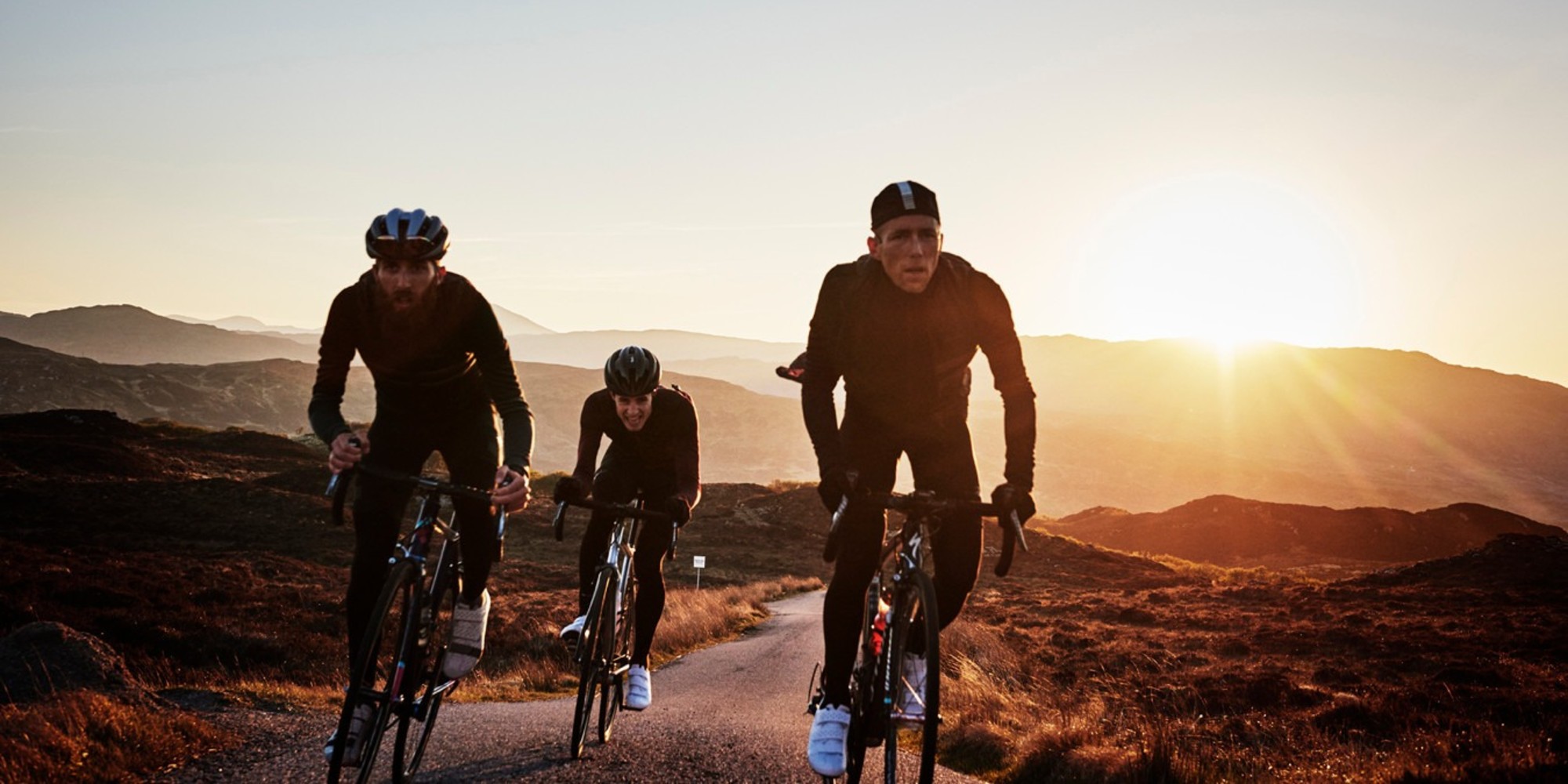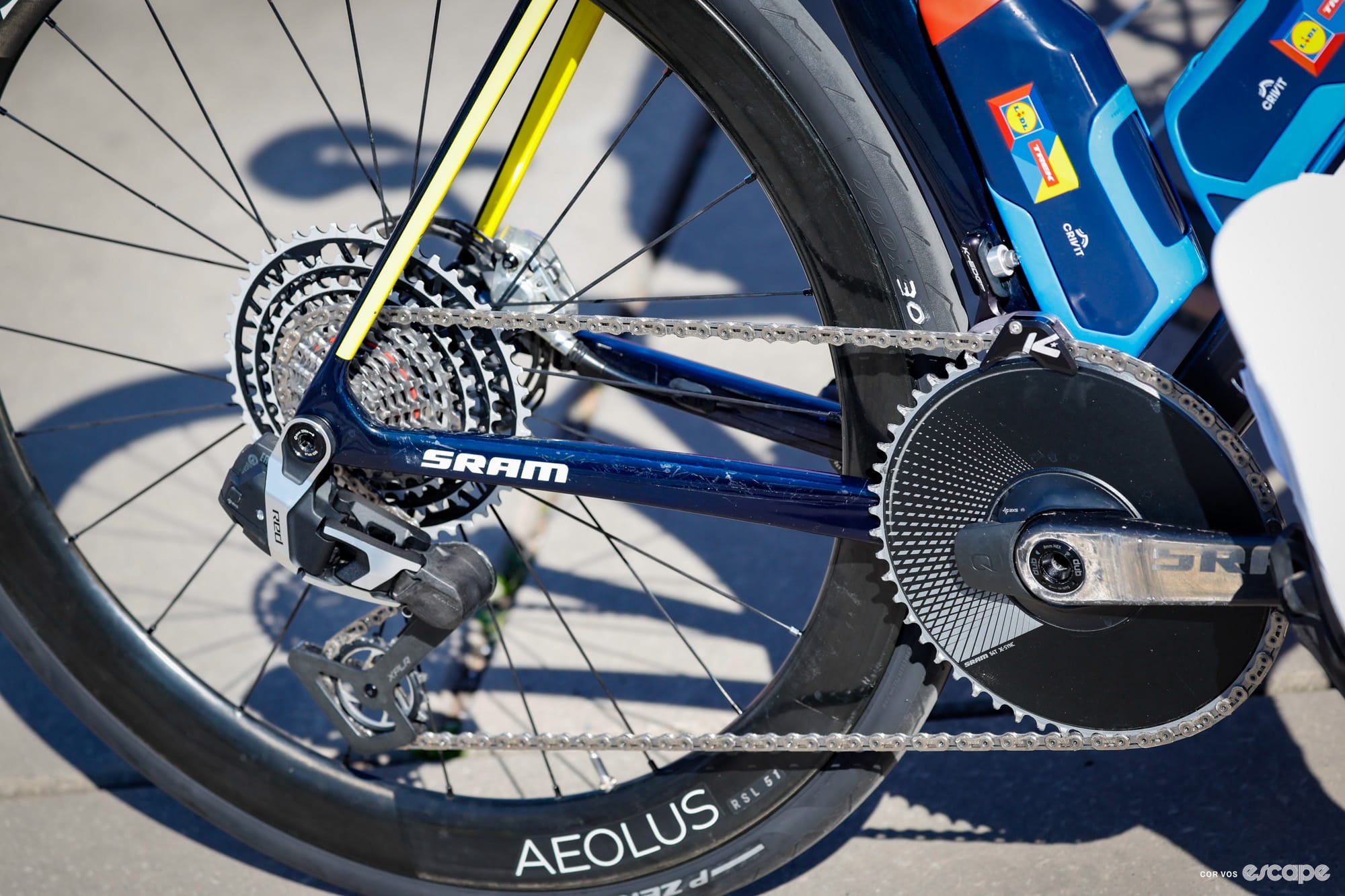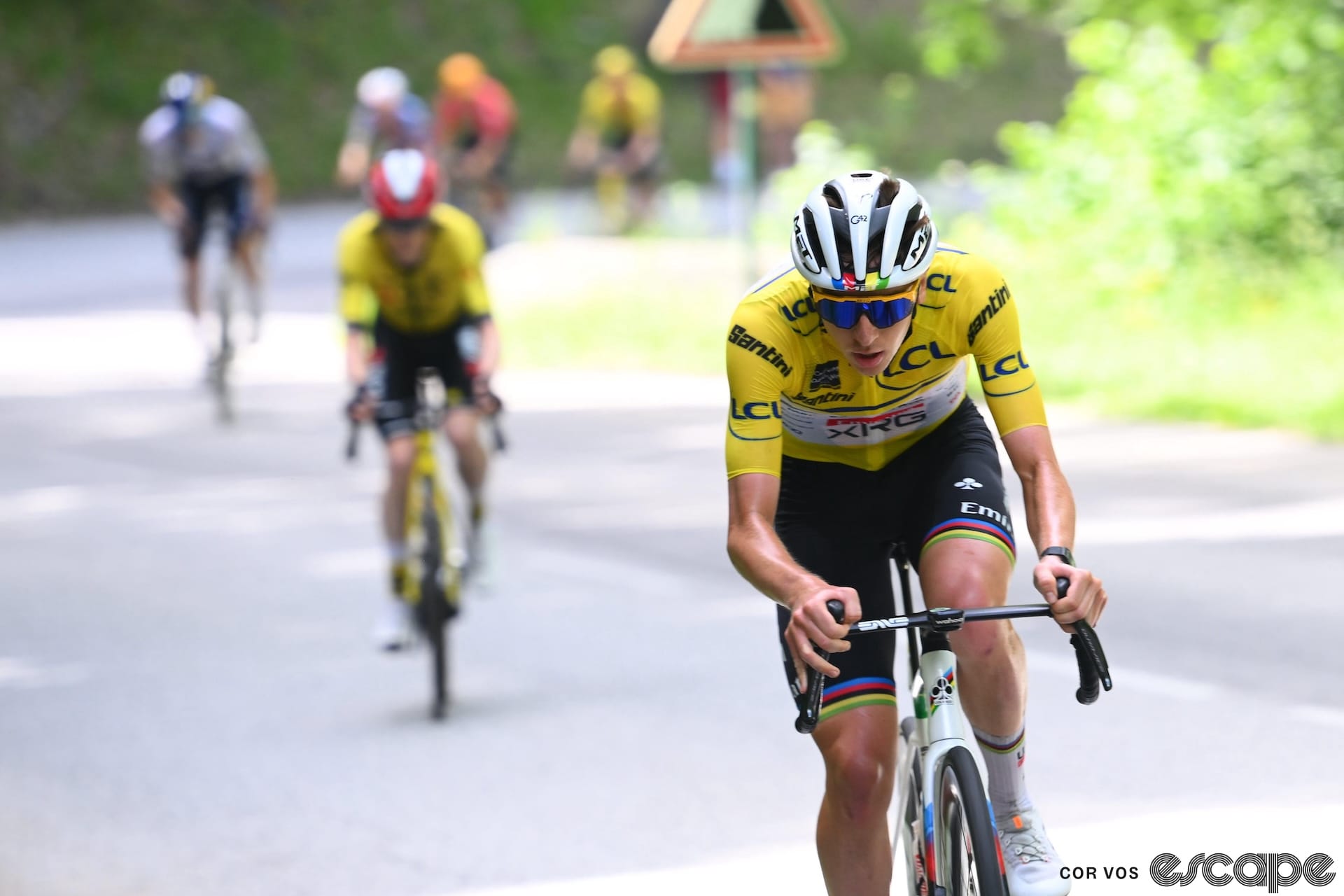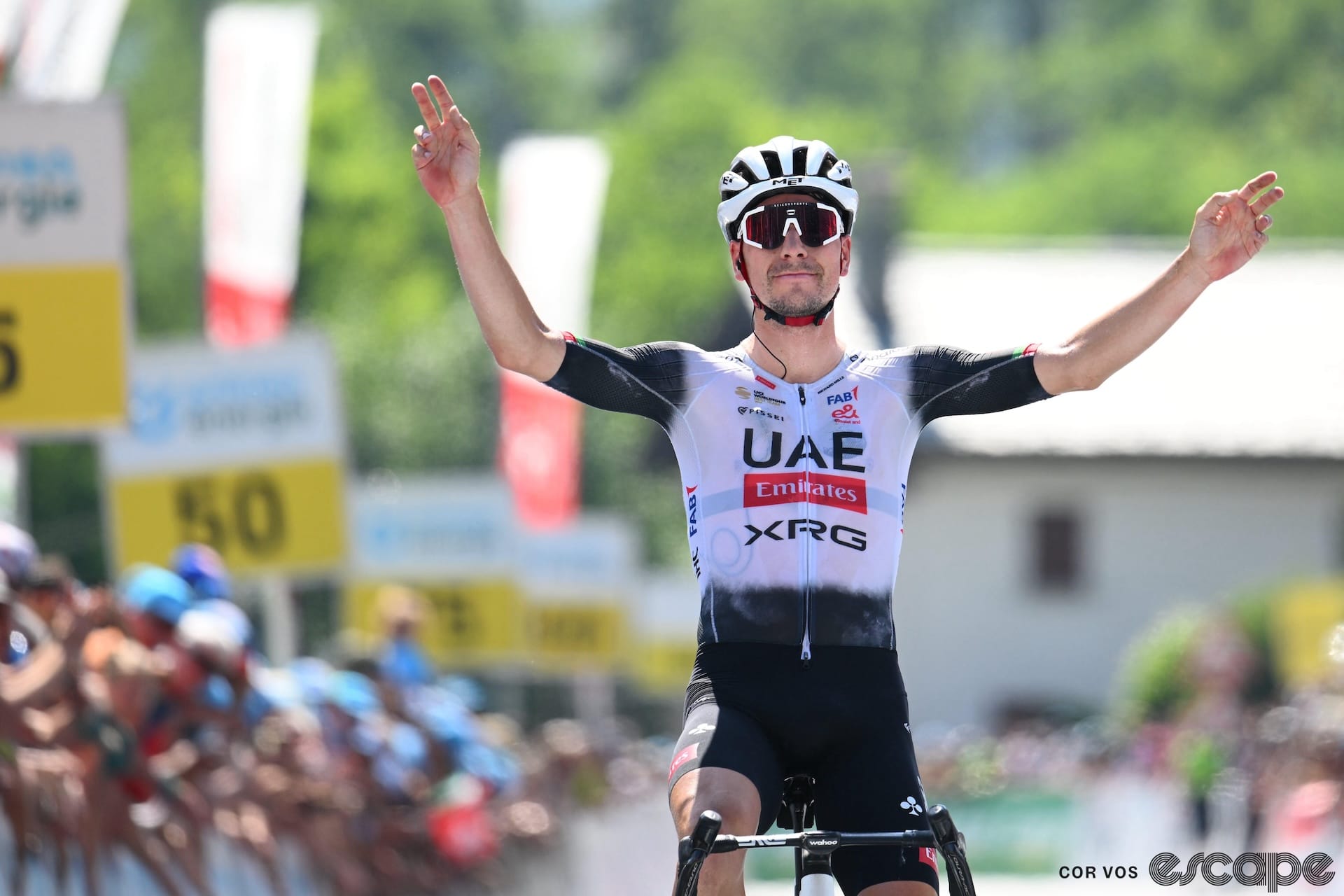I first encountered Rapha around 2006, just a couple of years after their launch. It was at Melbourne’s now-defunct Cafe Racer after a morning ride, where I spotted someone wearing their Classic Softshell jacket. The off-center zip, asymmetrical leather-like shoulder, and enigmatic black-on-black logo immediately caught my eye.
Curiosity got the better of me, and I went and tracked down their website. I was drawn in by the visceral imagery and storytelling, with a mysterious product range (Paul Smith collabs? Wool?). I couldn’t quite put my finger on it, but it spoke to me. The brand’s visual language – from the typeface to the content – evoked a sense of cycling’s golden era, where style and hardmen were intertwined, and I felt like I was learning more about cycling’s history with each click.

When Rapha debuted in 2004, their initial product line was small but distinctive: mostly black wool-blend jerseys (which came with arm warmers), a pair of bib shorts, vest, and accessories adorned with their iconic white stripe. Despite being in my racing prime, covered in sponsor logos and representing everything Rapha was not, I was drawn to its subtle elegance. I wasn’t even sure where I’d wear their gear if I had it, but I knew I wanted to look like those riders in the photos.
In Melbourne, Rapha sightings were rare: maybe a logo peeking out from under a jersey, a pair of gloves, or an Essentials case at the cafe. There were always whispers about Rapha coming to Australia, but it never seemed to happen. That mystery surrounding the brand only added to the allure.
Fast forward to 2009, after I’d been laid off from my day job. A friend asked if I wanted to help out the Rapha-Condor-Sharp team at the Herald Sun Tour, driving the van, checking the team into hotels, and helping with logistics. I thought, “Why not?” It was a chance to experience a race from a different perspective.
By that time, I’d already started CyclingTips, and I figured I’d blog each day about the experience. The team led by DS John Herety and riders like Tom Southam, Simon Richardson, Dean Downing, Darren Lapthorne, Matt Cronshaw, Ben Greenwood and Kristian House was welcoming, and it was exciting to help out. Brad Wiggins might have won that year’s Sun Tour, but Rapha-Condor-Sharp were the coolest-looking team in the race with their sleek black and pink kits, and Kristian in the British national champ’s jersey. They looked like pure class among the sea of traditional garish team kits.

That experience sparked my relationship with Rapha and eventually led to me working with them and establishing the business in Australia and New Zealand. I didn’t know anything about the cycling industry, sales, or marketing, but it was an incredible new career path I was on. At that time, Rapha had maybe 40 or 50 employees and was growing fast. I think I was employee #41 (fact check needed). The energy was contagious — everyone was young, passionate, and full of ideas. Rapha’s brand platform using 'Ex Duris Gloria' (Glory through Suffering, an essay written by Graeme Fife) at its core tapped into something deep for cyclists – a profound insight that resonated with people in a way we hadn’t seen before. From that point onward, the word suffering had entered the cyclist’s lexicon.

I watched my colleagues around the globe host events and create content that became iconic – roller races, the Gentleman races, Tweed Rides, irreverent (and competitive) cyclocross races with tequila shortcuts and bubble pits, ambush cheering squads at races, coffee out of H-vans (what a nightmare those were), the Rapha Continental film series (Slate Olson was the brilliance behind so many of these). We followed suit, and even broke new ground in our own Aussie way.
Although it might have looked like it from the outside, there was no master plan behind each of these activities. Just a simple but genius brand platform that everyone immediately understood and ran with. The employees were easily able to adopt the mindset of the customer, because they were the customer. We were having fun building on the ideas in other markets, but I could see that Simon Mottram, Rapha’s founder and my boss at the time, was sometimes uneasy with the direction we would take things. Cycling was still seen as a serious sport, after all. But he once told me with a subtle sigh, “If you want to see something grow, you need to release control.”
The vision was "to make cycling the most popular sport in the world," and we all believed we were doing something towards that mission. Finally, some who cared as much about cycling as we all did and had ambitions for it far greater than we could imagine ourselves.
After leaving Rapha to pursue my own endeavours, I watched as the brand seemed to take over everything in cycling. By 2016, Rapha was a force in the cycling world, not just in apparel but in every aspect of the sport — events, travel, ambassador programs, RCC, cycle clubs, a new mountain bike range, WorldTour sponsorships, films, and even collaborations with mainstream brands like Palace and Apple that transcended cycling. When Simon sold the business in mid-2017, I was genuinely happy for him. I knew how hard he had worked, and I thought Rapha was about to achieve even bigger things.
But things didn’t go quite as expected. Rapha had to make some tough decisions, and for the first time, it seemed like not everything was turning to gold. Later, when Simon stepped away from the day-to-day, the brand no longer speaks to me in the way it once had. Now, I find myself longing for the pared-down subtlety of a Country Jersey, or the dependable City Riding gear I could get away with wearing to the office. Instead, Rapha seems caught in an awkward transition phase trying to be a Lululemon and clinging to their core customer who has moved on to the very brands Rapha had helped inspire.
The magic details, like the little stories inside the garments, or the pink la Gazzetta tissue paper in the packaging are now gone. The blank-faced models on the website who look 30 years younger than me, wearing styles I could never pull off in the studio rather than on the roads of the Pyrenees. This appears to have come from the Arc'teryx style guide (a brand with similar roots going through a transition itself) instead of the originality and authenticity it once exuded. Maybe that’s okay – perhaps it’s Rapha’s way of appealing to a younger, more inclusive audience that cycling desperately needs in order to be the most popular sport in the world. I applaud their efforts to make cycling more accessible, whether through skirts, hijabs, or other products aimed at underrepresented cyclists. I’m a lifer, and even if Rapha has moved on from me as their core customer, I’ll always be riding a bike. And maybe that’s the point.
Cycling has a lot to thank Rapha for. Simon understood how fashion drives culture, and how influential fashion could be on the sport. They identified and popularized trends near the beginning. No, they didn’t invent gravel riding or bikepacking, but they showcased it in a way very few others were doing at the time.
As the famous adage goes, "there’s a gap in the market, but is there a market in the gap?" Rapha most certainly created a market that didn’t know what they wanted until they saw it. Many other brands exist now because of this new market, many existing brands have significantly upped their game, and cycling is a much more vibrant place than it used to be.
Happy 20th anniversary, Rapha. You’ve given far more to cycling than you’ve taken.
Did we do a good job with this story?






